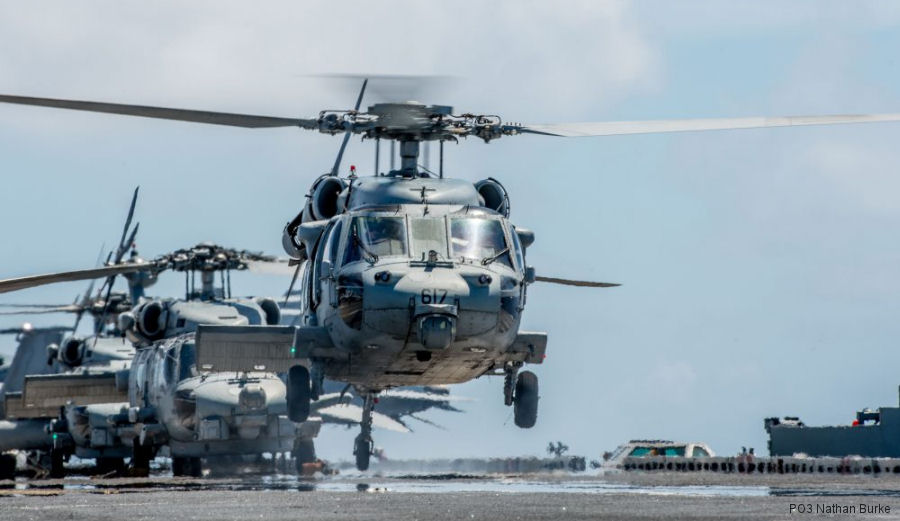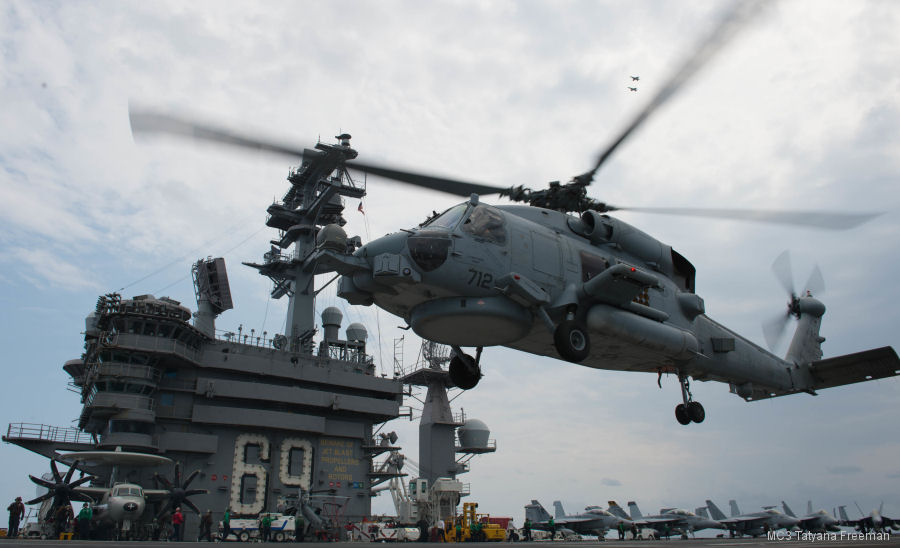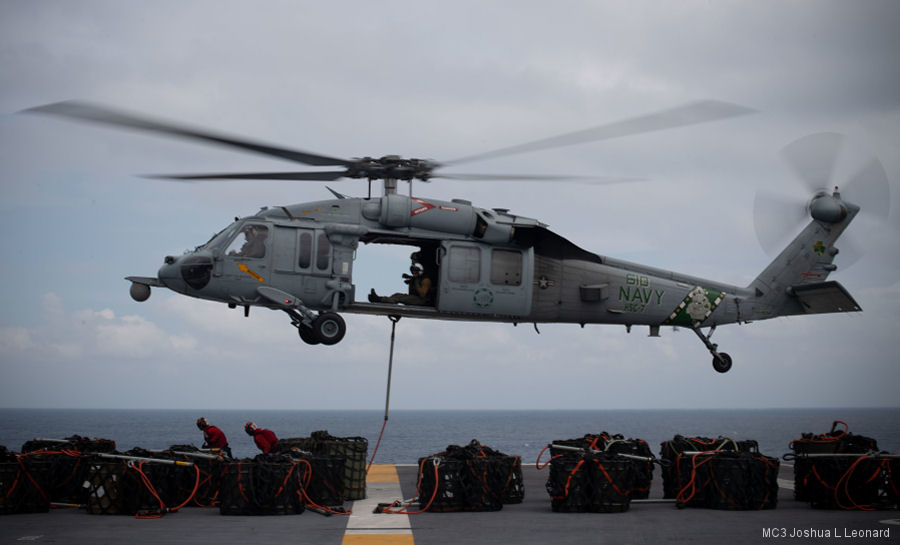
US Navy, September 28, 2019 - Aboard the USS Dwight D Eisenhower by MC3 James Norket - Carrier Air Wing (CVW) 3 consists of many different aircraft and platforms that all work together with multiple surface and sub-surface ships to form Carrier Strike Group (CSG) 10.
The “Dusty Dogs” of Helicopter Sea Combat Squadron (HSC) 7 and the “Swamp Foxes” of Helicopter Maritime Strike Squadron (HSM) 74 are comprised of similar aircraft, but have very different responsibilities while embarked on Ike.
HSC 7 flies MH-60S Seahawks, which are designed to be lighter weight for transportation of personnel and supplies.
HSM 74 flies MH-60R Seahawks, and they are equipped with more radars and equipment that is used to locate and identify surface and sub-surface contacts that are near the strike group.
Although both aircraft have unique qualities, the air crewmen that fly with the squadrons receive much of the same training.
“We both bring tools to the table,” said Chief Naval Aircrewman (Helicopter) Aaron Hutchinson, HSC 7’s Operations departmental leading chief petty officer. “We try our best to work together to accomplish the bigger picture.”
HSC 7 is comprised of 240 enlisted and commissioned personnel and four MH-60S Seahawk helicopters. The MH-60S is compatible with several weapons systems, but has a large, roomy cabin for personnel.
“Our aircraft are designed to support operations like vertical replenishments, tactical missions, anti-surface warfare and search and rescue (SAR) evolutions,” said Hutchinson. “The MH-60S is designed with a more roomy cabin in order to support our primary objective, SAR.”
During flight operations, the Navy requires a “plane guard” to be airborne in case of an emergency. On Ike, HSC 7 fills that role.
“We are the first to take off and the last to land,” said Hutchinson. “No aircraft can land or launch if we aren’t in the air. We are the safety net that is in place if something were to go wrong.”
HSM 74 is comprised of four MH-60R Seahawks and 285 enlisted and commissioned Sailors. They also have attachments on the cruisers and destroyers in the strike group, normally consisting of two helicopters. The MH-60R is compatible with many of the same weapons as the MH-60S, but they are also equipped with torpedoes.
“Our helicopters are designed with more technology that is used in locating and tracking contacts,” said Lt. Mathew Soper, a pilot assigned to HSM 74. “We circle the ship and communicate with other aircraft about surface and sub-surface contacts.”
The MH-60R is the only anti-sub-surface asset that is attached to the Ike. They are the first defense against submarines.
“Our primary mission is to locate and identify threats that are close to the ship,” said Soper. “We have the technology and weapons systems to protect the ship from most threats.”
The “Swamp Foxes” play a huge role in transiting straight and operating in tight waterways said Soper.
Each squadron has a different job to do, but each is necessary for Ike to get back to business.
“At the end of the day, we work together to complete the mission at hand,” said Hutchinson. “I think we complement each other nicely.”
See also Navy H-60 Seahawks
The “Dusty Dogs” of Helicopter Sea Combat Squadron (HSC) 7 and the “Swamp Foxes” of Helicopter Maritime Strike Squadron (HSM) 74 are comprised of similar aircraft, but have very different responsibilities while embarked on Ike.
HSC 7 flies MH-60S Seahawks, which are designed to be lighter weight for transportation of personnel and supplies.
HSM 74 flies MH-60R Seahawks, and they are equipped with more radars and equipment that is used to locate and identify surface and sub-surface contacts that are near the strike group.
Although both aircraft have unique qualities, the air crewmen that fly with the squadrons receive much of the same training.
“We both bring tools to the table,” said Chief Naval Aircrewman (Helicopter) Aaron Hutchinson, HSC 7’s Operations departmental leading chief petty officer. “We try our best to work together to accomplish the bigger picture.”
HSC 7 is comprised of 240 enlisted and commissioned personnel and four MH-60S Seahawk helicopters. The MH-60S is compatible with several weapons systems, but has a large, roomy cabin for personnel.
“Our aircraft are designed to support operations like vertical replenishments, tactical missions, anti-surface warfare and search and rescue (SAR) evolutions,” said Hutchinson. “The MH-60S is designed with a more roomy cabin in order to support our primary objective, SAR.”
During flight operations, the Navy requires a “plane guard” to be airborne in case of an emergency. On Ike, HSC 7 fills that role.
“We are the first to take off and the last to land,” said Hutchinson. “No aircraft can land or launch if we aren’t in the air. We are the safety net that is in place if something were to go wrong.”
HSM 74 is comprised of four MH-60R Seahawks and 285 enlisted and commissioned Sailors. They also have attachments on the cruisers and destroyers in the strike group, normally consisting of two helicopters. The MH-60R is compatible with many of the same weapons as the MH-60S, but they are also equipped with torpedoes.
“Our helicopters are designed with more technology that is used in locating and tracking contacts,” said Lt. Mathew Soper, a pilot assigned to HSM 74. “We circle the ship and communicate with other aircraft about surface and sub-surface contacts.”
The MH-60R is the only anti-sub-surface asset that is attached to the Ike. They are the first defense against submarines.
“Our primary mission is to locate and identify threats that are close to the ship,” said Soper. “We have the technology and weapons systems to protect the ship from most threats.”
The “Swamp Foxes” play a huge role in transiting straight and operating in tight waterways said Soper.
Each squadron has a different job to do, but each is necessary for Ike to get back to business.
“At the end of the day, we work together to complete the mission at hand,” said Hutchinson. “I think we complement each other nicely.”
See also Navy H-60 Seahawks


See also |
Seahawk in
HSM-74
HSC-7
Sikorsky MH-60S Seahawk
Sikorsky MH-60R Seahawk




